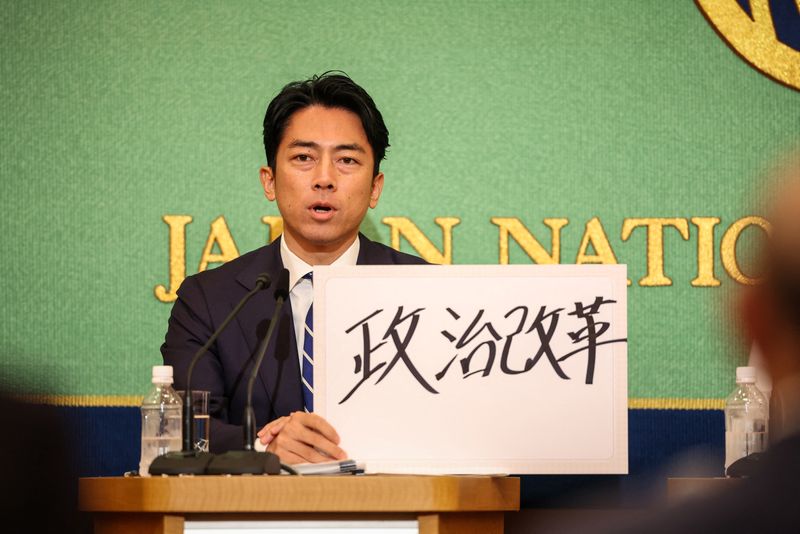By Tim Kelly
TOKYO (Reuters) – In the race to become Japan’s next leader, young contender Shinjiro Koizumi has positioned himself as a change candidate, but his veteran rivals Shigeru Ishiba and Sanae Takaichi are the ones pushing policies that could rock the boat diplomatically.
The Liberal Democratic Party, which has ruled Japan for almost all of the post-war era, will on Friday pick a new leader to replace Fumio Kishida as prime minister.
That comes at a pivotal moment for Tokyo as it seeks to deepen ties with long-time ally Washington and solidify a perennially testy relationship with South Korea, in an effort to present a united front against an increasingly assertive China.
Koizumi, 43, the U.S.-educated heir to a prominent LDP dynasty, is promising to usher in a generational shift in political leadership, but one that remains at ease with a U.S. relationship that shapes Japan’s foreign policy.
Koizumi is in a closely fought race with two experienced candidates who appear more willing to push back against Washington – former defence minister Ishiba, 67, who is fighting his fifth and he says his last leadership election; and Takaichi, 63, the nation’s economic security minister.
“Among the current top three candidates, Koizumi would probably be the most favourable if the U.S. had a say,” said Jeffrey Hornung, Japan Lead for the RAND National Security Research Division. “He is young, and he doesn’t have the governing experience and so the easiest path is to move forward with what’s already working.”
Koizumi demonstrated his close relations with Washington in July when he spent a day surfing with U.S. Ambassador to Japan, Rahm Emanuel.
While analysts say Koizumi would seek continuity, Ishiba could seek to strike a more independent foreign policy from Washington while Takaichi could revive historical animosity with Seoul.
Some recent opinion polls show them ahead of their younger rival among the LDP’s party members who will decide Friday’s election, one of the most unpredictable in decades because of the waning influence of powerful factions within the party and a record nine candidates.
Whoever wins, the U.S. election in November could have a bigger impact on Japanese-American ties, especially if any second term for Donald Trump revives pressure on allies to pay more for U.S. protection or subjects them to trade tariffs.
A spokesperson for the State Department said the U.S. was looking forward to working with the next Japanese leader.
South Korean President Yoon Suk Yeol, who has faced political backlash for pursuing security cooperation with Japan, told Reuters he is confident that Kishida’s successor “will agree on continuing to further develop our bilateral relations.”
A spokesperson for China’s foreign ministry said Beijing was willing to work with a prime minister that would promote a “stable China-Japan relationship.”
CONTENTIOUS ISSUES
None of the candidates are likely to abandon Kishida’s plan to double Japan’s defence spending to deter China from using military force in East Asia, or step back from an alliance with the U.S. that has guaranteed Japan’s security for decades.
But both Ishiba, a rare dissenter within the LDP, and Takaichi, a hardline conservative, could complicate U.S. ties at a sensitive time.
Washington is upgrading its military command structure in Japan for the first time in decades, broadening security cooperation into semiconductors and military technology, and is pushing Japan-South Korea detente to help contain Chinese power.
“Ishiba might try to push the envelope on contentious issues,” said Nick Szechenyi, a Japan expert and deputy director for Asia at the Center for Strategic and International Studies.
Among them is an agreement that governs the status of U.S. bases in Japan that host the biggest overseas concentration of U.S. forces.
On the campaign trail in Okinawa, Ishiba said he would seek more oversight over how Washington uses those bases. He also wants Washington to give Japan a say in how it would use nuclear weapons in Asia.
Another of Ishiba’s campaign proposals for Japan to lead the creation of an ‘Asian NATO’ has already been dismissed as hasty by the assistant U.S. secretary of state for East Asia and the Pacific, Daniel Kritenbrink.
In an interview with Reuters, Ishiba also criticized U.S. opposition to Nippon Steel’s bid for U.S. Steel, a politically sensitive deal in a pivotal election swing state, saying it unfairly cast Japan as a national security risk.
Kishida has declined to address an issue he says is a matter for the companies involved to resolve and Koizumi has urged his party colleagues to avoid making comments that could be seen as interfering in the U.S. presidential election.
If Takaichi wins the leadership race and becomes Japan’s first female prime minister she could create problems for the U.S.-led effort to pull Tokyo and Seoul closer together with her promise to visit the controversial Yasukuni war shrine.
Japanese leaders in 2013 stopped going to the shrine, which commemorates war dead including those convicted by an Allied tribunal of war crimes after World War II. That followed criticism from the U.S. and condemnation from South Korea and other nations that view the site as a symbol of Japan’s wartime aggression.
“She’s the hope of the conservative LDP members now,” said Tetsuo Kotani, senior fellow at The Japan Institute of International Affairs, a Tokyo-based think tank. “They are still very much skeptical about the future of the Japan-Korea relationship.”

